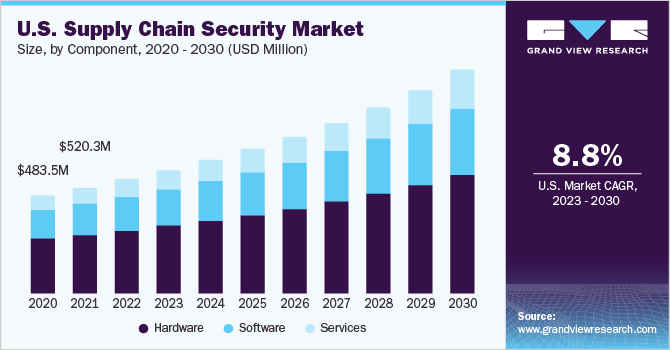The global supply chain security market was valued at USD 2.13 billion in 2022 and is projected to experience a compound annual growth rate (CAGR) of 11.1% from 2023 to 2030. The rise in cyberattack incidents targeting supply chain processes is anticipated to increase the demand for supply chain security solutions. These solutions enable organizations to effectively manage risks associated with external vendors, transportation, suppliers, and logistics. Additionally, the growing emphasis on transparency and sustainability is further propelling market expansion. However, the high costs associated with implementing security measures may hinder growth, particularly among Small- and Medium-Sized Enterprises (SMEs). Supply chain cyberattacks typically exploit vulnerabilities in software systems, which can include piracy, malware, unauthorized access, and malicious backdoor breaches.
Gather more insights about the market drivers, restrains and growth of the Supply Chain Security Market
Market Dynamics
The surge in adopting advanced solutions and the growing focus on digitization are generating vast amounts of data in the industrial sector. The concept of Industry 4.0 is becoming increasingly prominent, with companies from various sectors integrating cutting-edge solutions and technologies that deliver real-time operational insights. Moreover, the necessity to simplify supply chain processes, cut operational costs, enhance productivity, and ensure swift and secure delivery of goods is driving organizations to implement supply chain security solutions. The widespread adoption of advanced technologies is resulting in the accumulation of significant volumes of valuable business data that can yield diverse insights.
Companies’ emphasis on data-driven decision-making has spurred the utilization of Big Data and data analytics in supply chain management. Several governments worldwide have initiated projects to improve supply chain management by deploying the latest technologies. As the adoption of these technologies rises, the demand for supply chain analytics has surged in recent years. At the same time, cyberattacks are becoming more sophisticated, leading to increasing financial losses. With new networks being established and existing ones expanded, these systems are increasingly susceptible to cyber threats, contributing to the growth of the supply chain security market.
The increasing vulnerabilities within the supply chain can result in delays in delivery timelines, unregulated costs, and loss of intellectual property. Such system breaches can disrupt, damage, or even dismantle multi-tiered operations. Both SMEs and large enterprises are increasingly adopting security solutions to mitigate these risks and enhance the security and efficiency of their processes, ensuring resilience against sudden disruptions. Additionally, many large companies are heavily investing in technologies like the Internet of Things (IoT), blockchain, and Artificial Intelligence (AI) to improve supply chain transparency. Data collected via IoT devices allows users to optimize efficiency, make informed resource allocations, and minimize data waste.
Moreover, AI technologies facilitate real-time monitoring and forecasting of inventory levels, ensuring the smooth flow of products throughout warehouses. AI also enhances demand forecasting, risk management, customer and supplier relations, and logistics operations. Blockchain technology reduces the need for third-party involvement, thereby shortening transaction times and improving transparency in supply chain activities. However, the significant costs associated with these security solutions remain a major challenge for market growth. Many SMEs face budget constraints that limit their ability to address cybersecurity challenges and invest in high-end technology solutions to improve supply chain efficiency. This financial limitation can significantly restrict the implementation of effective supply chain security models among SMEs.
Order a free sample PDF of the Supply Chain Security Market Intelligence Study, published by Grand View Research.


